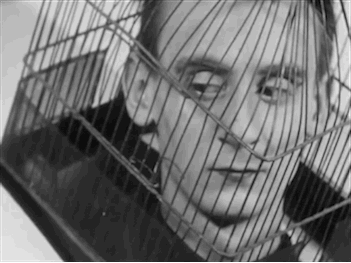
‘Sidney Peterson was one of, if not the most influential pioneers of avant-garde film of the 20th century. He was/is held in the highest regard by all as one of the kingpins of the avant-garde film renaissance that took place in San Francisco in the early 1950s. Peterson is one of the few artists that was fully respected and appreciated not only after his death but during his life as well. So respected, in fact, that he was given the opportunity to found what was called “Workshop 20” at what was then called The California School for Fine Arts (The San Francisco Art Institute), thus forming the first class to ever be offered teaching film. Peterson used students both behind the scenes and for actors and actresses so most of the classes consisted of filming under Peterson’s supervision. For The Cage, “he chose the student with the maddest expression as the protagonist”. This is coincidental because that student went on to drop out of school half way through shooting and abandon the film, requiring the use of another actor.
‘Both of Peterson’s films The Lead Shoes and, The Cage have found their niche among other classic films that Peterson himself would regard as, “the boiler plate of the Museum of Modern Art.” Using the techniques of his major influences, Dali and Bunuel, Peterson was able to take and incorporate previous used camera techniques with some newly fabricated techniques of his own. Peterson illustrates this fact in a quote found in Sitney’s Third Edition of Visionary Film, when he says that his film, The Cage was filmed using, “every trick in the book and a few that weren’t.” These two films fit a style that seems to follow Peterson through all of his work. They are open to and seem to fit an enormous array of different interpretations.
‘Peterson was aware of a fact that may hamper the ability of other great directors. Peterson would shoot “with the idea in mind that the structural coercion of the films comes in editing.” Because of this knowledge and his ability, Peterson is regarded as a master of synthesizing. Much of his work has been thought of as more interesting than successful. He was not always successful with his attempts, which is what makes him such a great artist. The Cage (1947) is one film, however, that is unanimously viewed as not only a success but also a foundation and point of comparison for the filmmakers that would follow Peterson.
‘Peterson taught the nation’s first fine art filmmaking courses at the California School of Fine Arts, known as Workshop 20. With his students, Peterson made a series of complex short, non-narrative films that drew inspiration from the psychological landscape of post-WWII San Francisco, figurative abstraction and music concrete. Peterson’s best known films from this period are Mr. Frenhofer and the Menotaur (1948) and The Lead Shoes (1949).
‘”The Lead Shoes proposes a comic vision that is not at all funny. Extravagant, exhausting, open to the fortuitous and the unintended, its picaresque narrative transforms the dark region of unconscious impulse into an intellectual burlesque. The ‘story’ disintegrates into a warped tissue of allusions and visual puns riddled by ellipses and audio-visual shifts.” — Stuart Leibman
‘Peterson was attracted to the Surrealist School of Cinema with its marvelous imagery drawn from the subconscious dream state and its unfamiliar time relationships. In accordance with Surrealist painting, Peterson made films that often distored camera imagery so that the viewer’s world became shifted in perspective.
‘”One thing the Museum of Modern Art taught me was that San Francisco has been an important center of production for short artistic films since the latter 1940’s” — Sidney Peterson
‘Sidney Peterson was born in Oakland, California, November 15, 1905. Attended University of California, Berkeley. He was a newspaper reporter for Monterey Herald in early 1920s. He lived in Paris and Southern France in late ’20s and early ’30s, painting and sculpting. He married Ruth Bosley and moved back to Berkeley, California; wife died shortly thereafter. He married Bernice Van Gelder and moved to San Francisco. Co-founded Orbit Films with Robert Gardner in 1950 to make documentaries. Museum of Modern Art, New York City: Director of Educational Television production, 1954-1955. Moved family to Santa Fe, New Mexico where he began writing a novel. United Productions of America (UPA), Los Angeles, California: Scriptwriter for animated series on lives of historical figures, especially artists, 1955-1956. Walt Disney Productions, Los Angeles: Scriptwriter and storyboard artist for Fantasia II (never completed), 1957-1958. Returned to San Francisco to finish novel, A Fly in the Pigment, published in 1961. Remained in San Francisco, writing and lecturing until he and his wife moved to England in the early ’70s.
‘From England they returned to live in New York City. In 1981 he made a film with Marjorie Keller, Man in the Bubble. His second wife died in 1990. He is survived by a daughter, Nora, who lives in New York City and he has one grandchild, Kevin.’ — Dan Anderheggen, Rebecca Barton, David Sherman, Dominic Angerame
____
Stills

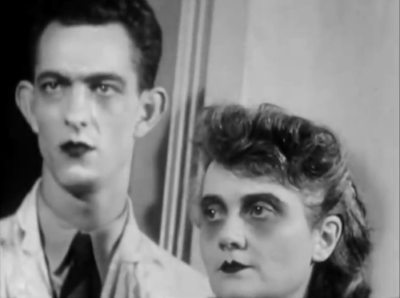
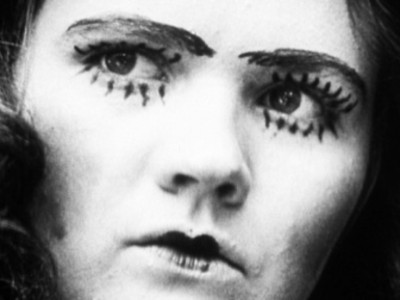
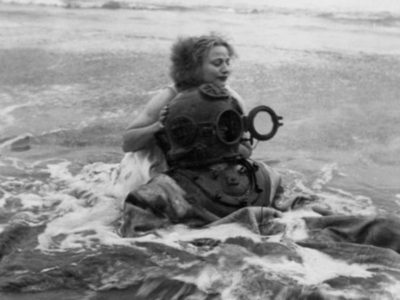


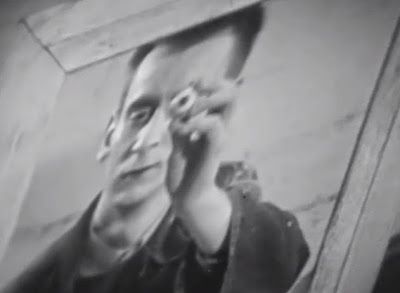


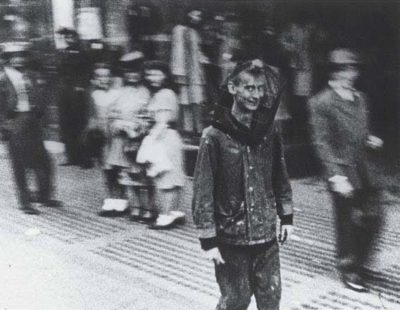
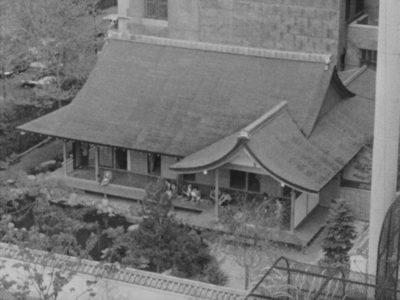
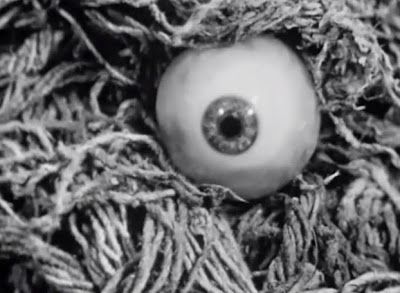
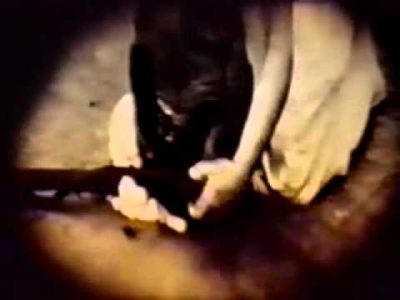
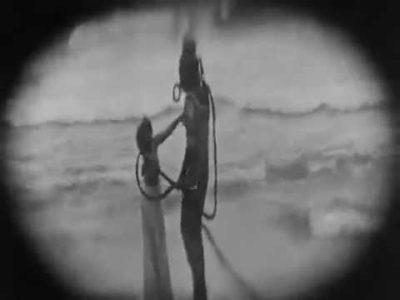
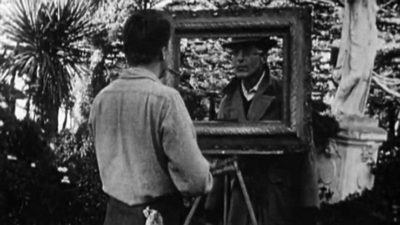
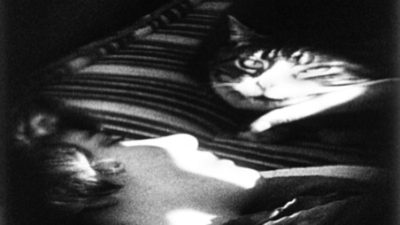







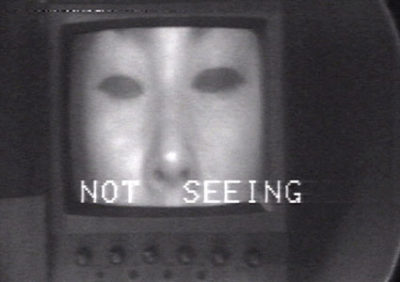

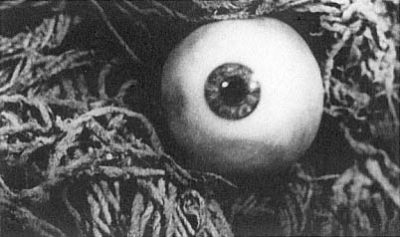
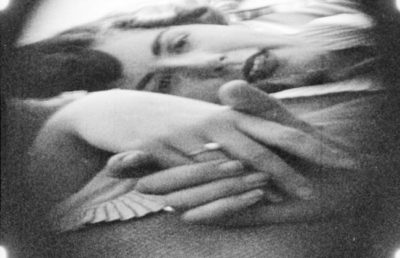
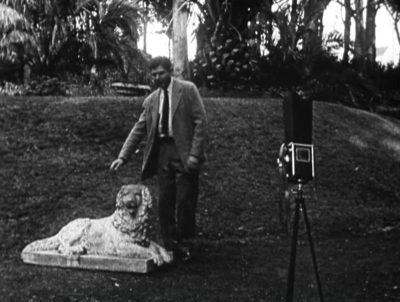
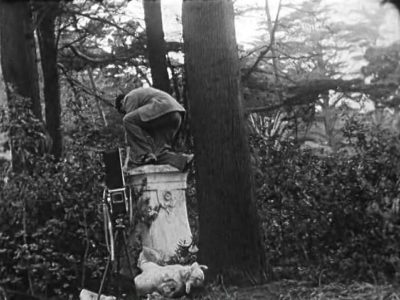

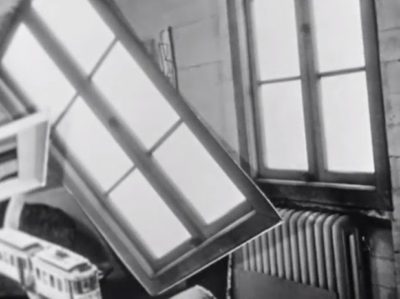
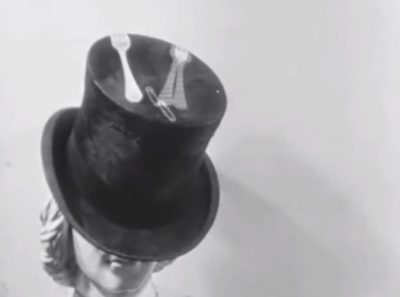
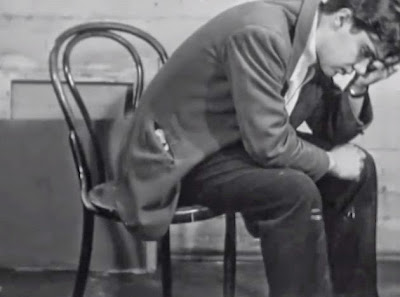

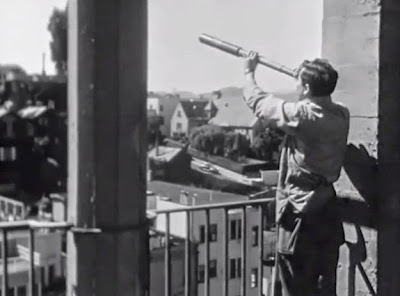
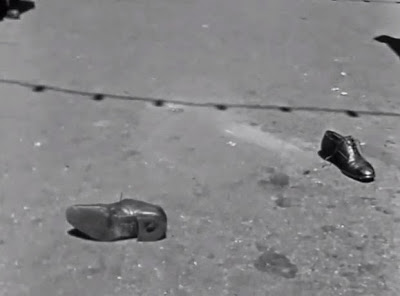
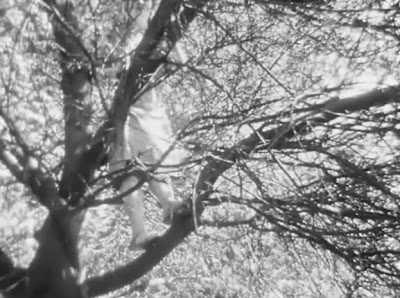
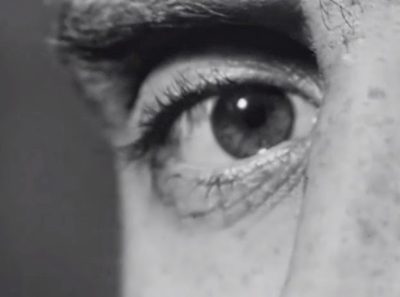
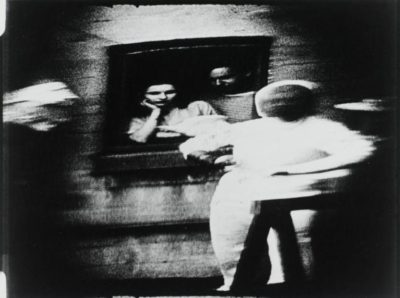

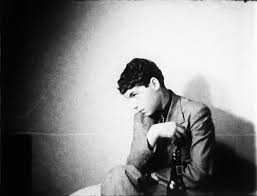
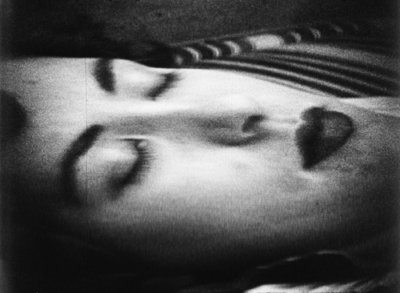

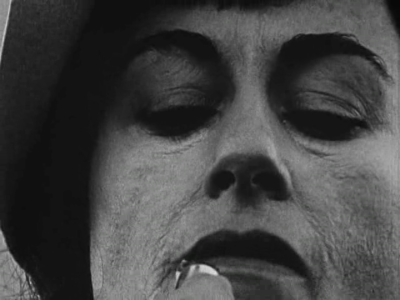
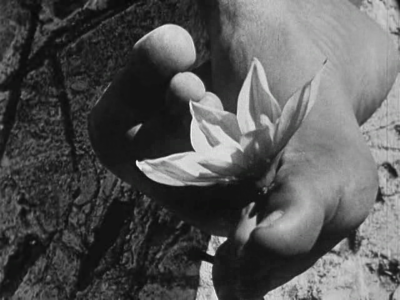
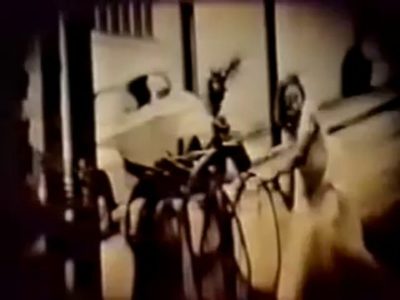

___
Further
Sidney Peterson @ IMDb
Book: ‘The Dark of the Screen’, by Sidney Peterson
Sidney Peterson @ The Film-Makers’ Cooperative
Sidney Peterson @ Canyon Cinema
Sidney Peterson’s San Francisco Surrealism
Sidney Peterson @ MUBI
‘The Lead Shoes’, by Kyle Westphal
Sidney Peterson @ letterboxd
“An essay I wrote on Sidney Peterson’s The Lead Shoes.”
#25 = 2/21/11 = James Broughton + Sidney Peterson
_______
A Period of Invention
by Sidney Peterson

San Francisco is a make-believe town. Forget its early Spanish history, although there’s a lovely church there. San Francisco really began in 1849, when it was populated by a vast number of men from every spot in the world— which meant that they didn’t speak the same language— who were looking for gold. At that moment in San Francisco’s history, everybody was able to achieve his own identity. If you looked like a doctor, you hung out a shingle, and by god you were a doctor. People were free to become whatever. It was a made-up society, totally uncertified, with this craziness, this kind of imagination. I don’t think there ever was a town that was quite so identified with the idea of inventing oneself. That conspicuously was part of the crazy story of the Gold Rush. Later, local people were able to manipulate the mild craziness that was left over from this period of invention.
My father was on the tail end of this. His father would have participated, if he’d happened to be there. So it’s all very close. It all took place in a half a century.
I was born in Oakland in 1905, and I grew up there, before World War I— which I call the semi-Victorian period. Devoid of television, radio. I went to movies like everybody else, but I have no particular recollection of them. When movies began to make some kind of a dent on me was when I lived in France in the thirties— the surrealists, Dali and Bunuel, and people like that. In a way that’s where my films came from, although without a direct relationship.
When I was sixteen I was put to bed for a year. My heart was too large for my anatomy. I was supposed to grow up to it. When I got up from that year in bed, they sent me out with a small bottle of something in case I had a heart attack. Not much of a guarantee that you’re going to have a long life. I had no expectations at all. The last thing in the world I dreamed of was reaching this advanced age. I stopped high school and went to art school [1921-25], including classes at California College of Arts and Crafts. Then I decided that I might as well take the Grand Tour. In those days it was possible to do that by getting work on a ship. I got a job as a storekeeper and sold bottles of Johnny Walker to the passengers for thirty dollars a bottle, which was the bar price for sixteen drinks. By the time I got to Naples, I was loaded and able to leave the ship and go to Rome, Florence, Paris, and stay around for quite a while. That was in the twenties. I saw Hemingway and the crowd at the Dome Cafe, but I was too young to be lost and not old enough to join them. That all became part of my life, and somehow I started chasing art around. I did go back to college at UC Berkeley for a few years [1925-27] with the idea of pre-med but I wasn’t serious enough about it.
Workshop 20 happened because James Broughton and I put together a movie. We were writing a play together, and it got to be too well talked out. James didn’t know anything at all about movies, so I probably suggested that we make a movie. (Jimmy Broughton didn’t shoot his films. Frank Stauffacher, who started it all, shot Broughton’s early films [ Mother’s Day (1948) and Adventures of Jimmy (1950)].)
We bought some film at a drugstore and got a camera. They were excavating and getting rid of the bodies in a cemetery, and I spotted a guy who was sort of wandering around the place and shot a picture of him. We added a few other things and made The Potted Psalm [1946]. Stauffacher was doing screenings at the San Francisco Museum of Modern Art, and when he heard that a film had been made in San Francisco, he showed it at the museum and it outraged everybody.
The Sanity in Art Society came out shaking their fists, and when it was screened again they showed up in a body just in order to walk out. The influence of the museum was taste making. I’ve always assumed they were interested in tastier movies.
Workshop 20 had a very specific time period, postwar, from about 1946 up to 1950. It was just for that brief period that Douglas MacAgy and his wife, Jermayne, had charge of things. 7 All the teachers at the School of Fine Arts abandoned figurative painting, but at the same moment they inherited a lot of guys who were older whom the government was paying for a reeducation. They caught on very quickly, just imitating the teachers. But the teachers were outraged at the students’ imitations. That wasn’t what it was all about. What it was about had to do with the imagination and ideas.
Film was being taught down in Hollywood, at UCLA, I guess. People would show up at our place in San Francisco because they heard it was a wilder place, more exciting. People who wanted to do something different— not just make movies and get a movie job. My students put together a number of movies. Some of them turned out to make some kind of sense, and some didn’t. There’d be maybe ten, twelve students 10 — ten bucks apiece studio fee. That bought film at the drugstore. Up to that time 16mm filmmaking had been strictly amateur— just what you could buy in the local pharmacy, so far as the basic material of the filmmaking was concerned.
There was the question, “We’re gonna make a movie— what will we make it about? You got any ideas?” Someone would suggest, “How about this ballad? . . . How about another ballad? We’ll put two of them together and try to make sense out of them.” One guy would say, “Well, I’ve got a friend who’s got a deep-sea diver costume. We could borrow that.” It’s an old comedian’s trick on TV— put some improbable things together and make a joke out of them. In a way, that was what was done. Milking material for maximum use in ways that explored ideas, mostly by associations of ideas. A lot of semi-Freudian type of interpretation. We weren’t analyzing any individuals but using it as a matter of technique. It was an easy way to talk about everything under the sun.
Each time we’d shoot something, we’d bring it back, and everybody would see himself doing something. We could use the school’s screen and projector to check the way the film worked on a big screen. That kept the spirits high; everybody was interested in what was going to happen next. With the collegial support of Hy Hirsh, who was a photographer at the De Young Museum, I shot them all myself. There was no reason not to.
The editing, though, was strictly personal. You can’t just shoot a film, you have to remake it; you don’t just write a book, you rewrite it. What many didn’t do is make the last connections— you have to make prints and cut them. There was an old guy at one of the labs in San Francisco who was interested in our films. He made it possible to make them, otherwise they would have just died in their tracks.
I edited at home. I chopped the film up, hung it up, put it together, scrambled it. I knew by that time what I wanted, how I wanted to put it together. That’s why P. Adams Sitney recognized so much of it as symbolic material. For instance, when The Cage opens, a top hat is coupled with knives and forks on top of it, cutlery just animated. That was intended to suggest the position of the artist when he belonged to an academy and had to wear a top hat and a stick coat— the awkwardness, the social situation. It imprisons the artist at a time when artists were trying to break out of precisely that kind of thing. Much of this material could be interpreted in one way or another if you were so inclined.
These films had a remarkable capacity to arouse anger. When they took some of the school stuff to Italy to show it at their biennale, the audience threw chairs at the screen. As the films got a little smoother, and easier to take, they had different qualities. I always thought Lead Shoes, the one with a deep-sea diver in it, was one of the first really feminist films. The woman’s role had certainly changed with the war. The film portrays the situation of the mother. The poor woman loses her support, the provider for her family. She gets nothing but trouble from her adolescent son. It starts out with another of those symbolic things: she takes a fall out of her window and lands in the lap of a gardener. The assumption here is that having a lover is part of a woman’s life. The deep-sea diver in the film represents the husband, the dead father of the adolescent character. There is a kind of story that attaches to it, but you can make it up as you go along. There was a workshop film I didn’t release, An Adagio for Election Day [1950]. I was sick, and a very aggressive student took over and finished off the story with some gunplay. It wasn’t in line with what we were doing at all. So I just forgot about it.
__________
8 of Sidney Peterson’s 17 films
___________
w/ James Broughton The Potted Psalm (1947)
‘In my opinion, the title itself describes Peterson’s definition of film as art: Great films are sacred songs that have, unlike ancient songs, a definite form, but they are also like plants, capable of growing in time. According to Merriam-Webster: “Potted” also means “drunk” in slang. I don’t if the word was used in this sense at the time, but if it was, then “Potted Psalm” might also mean a sacred but possibly irrational, debauched song. I think all of these interpretations, and others I can’t think of, can be true at the same time.’ — waysofseeing
footage collage (mute the sound)
___________
The Cage (1947)
‘In its final version The Cage describes the adventures of a “mad” artist. In a symbolic or real self-mutilation, he takes out his own eye, which immediately escapes from his studio and into an open field and then meanders through San Francisco. His blinding is accompanied by complete schizophrenia. He alternates with his double throughout the film. His girlfriend, who is also his model, frightened by his mad groping around his studio for the lost eye, gets a doctor. The girl, the doctor, and one of the two protagonists then chase around the city after the eye. Throughout the film the perspective alternates between that of the pursuers and that of the eye itself. The eye’s vision is filmed through an anamorphic lens (this results in the lateral and vertical distortion of images emphasized by a twisting movement of the lens which shifts the axis of concentration and elongation.) The strategy of the doctor is to catch the eye and destroy it. To save the eye, the double has to thwart the doctor’s attacks with darts and rifles. Eventually the eye is recovered, and the schizophrenic becomes the original young man. His first act as a reunited man is to knock out the doctor who otherwise would have ruined his recovery, and presumably, taken the girl. In a deliberately periodic ending, the artist and girl walk off hand in hand. He embraces her in a field, and she flies out of his arms into a tree.’ — Visionary Film
the entirety
___________
w/ James Broughton The Petrified Dog (1948)
‘After the premiere of Sidney Peterson and James Broughton’s *The Potted Psalm* caused a near-riot at the San Francisco Museum of Art, Douglas MacAgy offered Peterson the position of film-making instructor at this California School of Fine Arts. With classes composed mostly of inexpressive but sincere ex-GIs, Peterson embarked on a series of cooperatively-made films — one per semester — under the Workshop 20 banner.
‘Like the other Workshop 20 films, *The Petrified Dog* belongs to a species of the most casual, uncontemplated brand of American surrealism, free of any analytic mediation or symbolic intent. “Do you suppose movie audiences will ever learn to take works as experiences instead of merely as expression, what does it mean? etc.?” Peterson once mused. Often described as a version of *Alice in Wonderland*, this analogy is nonetheless inadequate in suggesting the structure of the film, which proceeds almost as if an assemblage of unrelated reaction shots from a half-dozen different movies. The soundtrack of *musique concrete* attempts nothing like synchronization with the picture, allowing instead two parallel experiences whose occasional harmony appears all the more felicitous.’ — Robert H. Spring
the entirety
_____________
Ah! Nurture (1948)
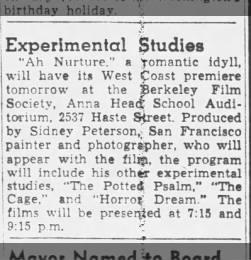
_____________
The Lead Shoes (1949)
‘The most important trick Peterson uses to fool our eyes is the distorted lens through which we see almost everything in the film. This device, used also in The Cage, distorts both the three-dimensionality of the space and the light balance. We are unable to experience the depth of field, as everything is flattened, especially on the sides. Neither can we trust the light to situate the characters and ourselves as it does not get reflected in a way we would expect. Moreover, the lights reflected for different objects get mixed and sometimes the light flashes unexpectedly from a dark object.
‘Any shot in the film would reflect the characteristics I described above but in some of them, Peterson emphasizes the effect. In one shot, the frame is divided to two by a vertical object. On the left we see the woman running towards us. On the right, we can see the stairways and all the things between it and a city. If Peterson shot it with “normal” lens we would experience “the time” she spends to run and the depth of the field until the city. However, we can see no difference between the right or the left. We “know” that the city is far but our eyes and what they perceive makes everything confusing.
‘The distorted lens also changes the way we perceive time. When there is no depth of field, no straight trustworthy lines, how are we to know how fast things happen? The obvious changes in the recording speed makes it even more complicated for us. We cannot say whether there is any scene shot in “real time” in the film. As in the scene I described in the last paragraph, the shots of the girl who is playing on the street gives us no clue how fast the girl is approaching us. Her fast moving legs prove that it is shown faster but visually she doesn’t move at all in the depth of field. A special case of change in the recording speed is the shots moving backwards in time. In one of them, the main character wears her shoes in reversed time but she walks straight to the door. Obviously, the way we experience the shot is against all the basic scientific principles we know.
‘The soundtrack is composed of people singing playing jazz songs or simply talking. What they say or do has nothing to do with what happens in the film. However, they have a very important function in the film in that they push our disorientation even further. In most films, music is very well synchronized with the movements in the film so that our illusion of moving time is enhanced. However, Peterson uses it for the exact opposite purpose. Although the soundtrack is actually continuously flowing, the changes in its tempo and rhythm give us no help in experiencing time like we do usually. A perfect example is a shot that recurs many times in the film. The camera follows the walking shoes of a person. The music is totally asynchronous to it (it usually is faster).’ — waysofseeing
the entirety
_____________
Mr. Frenhofer and the Minotaur (1949)
‘Based on Le Chef-d’Oeuvre Inconnu, Balzac’s Abstract Expressionist parable. .. should be studied by experimental filmmakers in every detail.’ — Parker Tyler
‘We are at the crux of Peterson’s genius: his ability to formulate a new perspective and to test its implications.’ — P. Adams Sitney
the entirety
_____________
A Japanese House (1955)
‘A Japanese House is a film MoMA produced in 1955 to document the installation of an actual, full-scale 17th-century Japanese house, designed by Junzō Yoshimura and named Shofuso (or “Pine Breeze Villa”), in our Sculpture Garden. The third house that MoMA’s Department of Architecture and Design constructed in the garden, Shofuso was chosen for its unique, traditional Japanese design characteristics, including post-and-lintel frame construction, flexible layout, purposeful relationships between indoor and outdoor spaces, and the decorative qualities of the structural system itself. With more than 1,000 visitors per day, the exhibition was so successful that the Museum extended its run multiple times.
‘The film is in many ways a traditional documentary, detailing a specific event at a certain moment, with explanatory narration. However, it is also a beautiful film, with many quiet, contemplative moments, careful camerawork, and artfully composed frames. Japanese in its execution, the film explores traditional elements of Zen and Shinto design, such as kukan/supesu (“space is not empty”). Long, lingering takes invite the viewer to ruminate on reflections in water or the shape of a doorframe, as if they were experiencing the house themselves. This film is the closest you can get to visiting Shofuso without actually being there. The house still exists, now reassembled in a park in Philadelphia.’ — MoMA
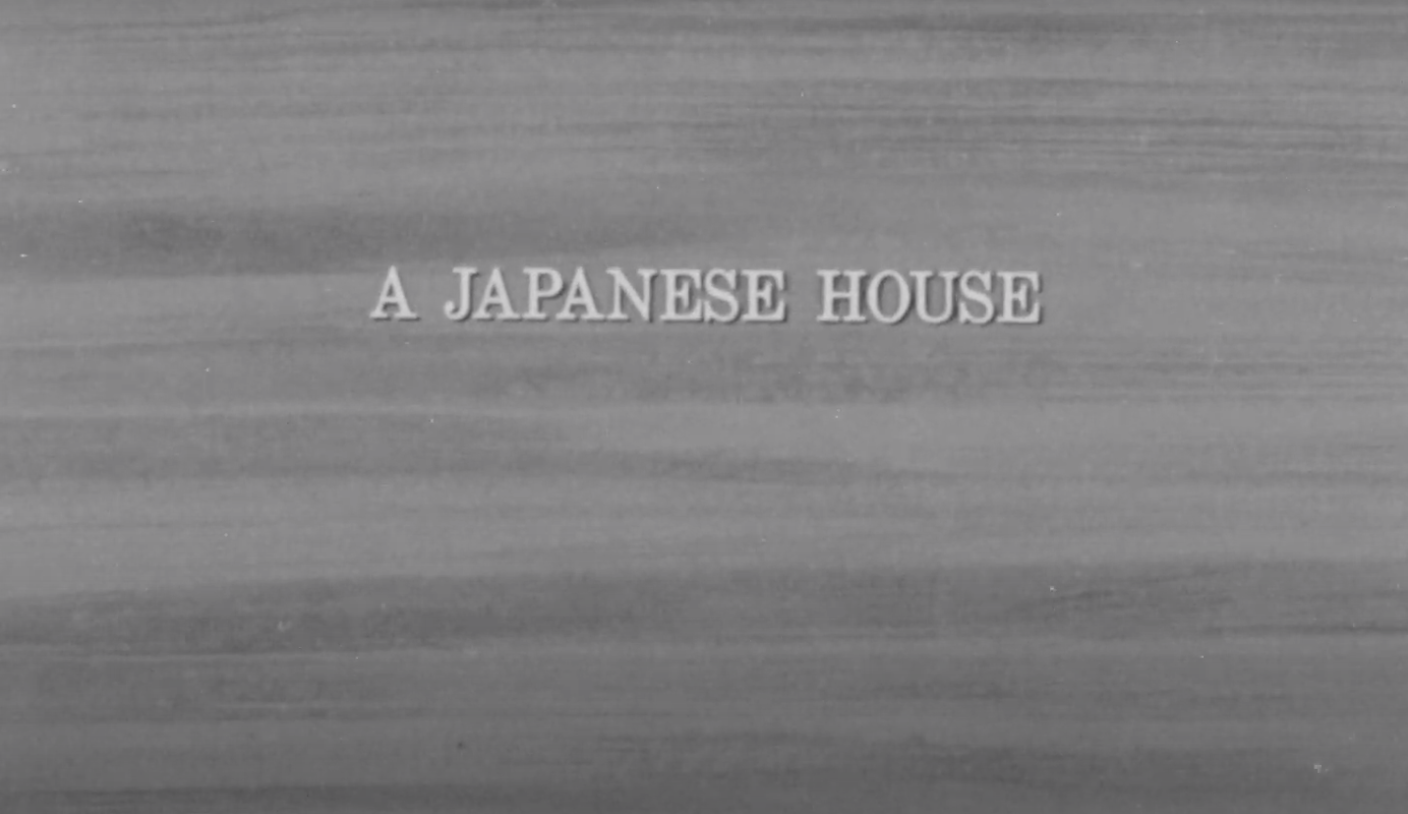
_____________
Man in a Bubble (1981)
‘There is a wild sound in the streets where once bells called men to prayer and choruses chanted in march time to the decibels of an infernal brimstone cacophony from which the damned in a Boschean hell sought refuge in the solitude of the philosopher’s egg, the transparent bubble of the alchemical Hermetic vessel. MAN IN A BUBBLE is a short documentary about personal acoustical space in an age of intolerable noise. Some stuff their ears against the electronic smog. Others wear headphones. A few scream and very few begin to discern in the deafening uproar the emergence of a Tondichtung worthy of the urban primitivism which gives birth to it. The film was shot in Chicago and New York.’ — Film-makers Coop
‘Peterson has always been good on street photography, and the fragmented views of New York and Chicago have a jangling abrasive kick.’ — J. Hoberman
‘I think you’ve managed one of the happiest most hopeful visions of yr life withOUT one jot of sentimentality to spoil it. The ‘dancers’/skaters, each wrapped in his or her own ‘bub’ is a tough weave of HARD joy … Bravo!‘ — Stan Brakhage

*
p.s. RIP Barbara Ess, Ian North. ** _Black_Acrylic, Hi, Ben. Happy to give you some daydreaming fodder. The international giant interest in Harry/Meghan seems like a sign that the world really has gone to hell in a hand basket. ** Ian, Hi. Thank you! You’ve snorkelled in the cenotes? Amazing, imaginatively at least. It’s weird: I grew up in LA and have spent most of my life there, and yet I’ve never been further south in Mexico than Tijuana and the Baja. Kind of inexplicable really. Still snow? You must be over it, but I can’t help but remain envious here in soggy at best Paris. ‘Day of the Locust’ is great, or so I remember. I even like the film version. Process, yep. I’m a process junkie whether it’s mine or someone else’s. Enjoy that phase? Happy Friday. ** David Ehrenstein, I have a soft spot for ‘Joanna’. Granted, I was probably on hallucinogens when I watched it. ** Dominik, Hi!!! Uh, I was going to say that I kind of maybe distracted myself, but I had really shitty sleep last night for the time in a long time, so maybe my stress just moved to a different location in me. I don’t know of flixtor.to, but you can bet I’ll figure out if it’s available. Thanks! Oh, right, My Chemical Reunion did a reunion thing, right? Wow, ideally, concert-wise? Hm. I’ll try to avoid saying Guided by Voices because duh, so … I think I’d like to get totally assaulted and thrash around for my first time, so some speed black metal band, I guess. Any of them, or Iceage as they were about 6 or so years ago before Elias went kind of Nick Cave-y and was still explosive. Ha ha. Do you have tattoos? I don’t have any. Never have wanted one, I don’t know why though ‘cos I like others’. Love drunk on champagne and screaming obscenities at his mirror reflection in a fake posh British accent, G. ** Jack Skelley, Jack Torrance! There, someone has finally used it. You can rest easy now. I’m kind of shocked no one has before. Weird. Snorkelling … you ever gone snorkelling? Where? I have. In Hawaii. It was an interesting combination of peaceful and frustrating. I wonder if almost everyone has gone snorkelling. Great that the tiny Eiffel Towers came in handy, but … what about the tiny Arc de Triomphes? And the berets? You just threw them in the trash didn’t you?! ** John Newton, Cozumel … I don’t know what that is. I’ll go find out. I’m reading … oh, I just put together one of my ‘5 books I read recently & loved’ posts that’ll go up here on Monday, so I’ll wait for that reveal so as not to spoil the surprise, ha ha. Why about you? Your busyness sounds like the good kind of busyness. Nice. ** Brian O’Connell, And a happy, happy Friday to you too, Brian! Yikes, that’s scary. I don’t think I’d want to die in an underwater cave, although it would maybe be better than dying in a not underwater cave. It’s kind of fun to let yourself get caught up in the Oscars’ charisma. To become one with all of vaguely cultural humanity. And it’s harmless. Except during most of the musical numbers. I don’t think I know anyone who isn’t at least slightly depressed right now. No, I can’t think of one. How does one, or you, I guess I mean, celebrate Pasolini’s b’day? By talking very loud and laughing hysterically for no reason? I used to take acid on Rimbaud’s birthday for years when I was young. Back when I used to run the reading series at this literary place called Beyond Baroque in LA, one time we celebrated Frank O’Hara’s birthday by serving everyone bowls of Corn Flakes and maybe toast or something because breakfast was FOH’s favorite meal. Today … we just got the estimated budget for Zac’s and my new film, so I’m sending it to the producers and then we’ll talk about it. This commissioned text I wrote to go with the new film by Steve Reinke and James Richards, whose films I love, seems to be loved by them, so I might eat a pastry to celebrate. Look at art. Stuff like that there. Did your Friday bloom? ** Hey. Today I continue my ongoing mission to spotlight works by experimental filmmakers of the present and the past by presenting the works of Sidney Peterson, a major dude in the field who is little known outside the experimental film buff scene but should be known, and today is me doing my little part to fix that. See you tomorrow.




 Now available in North America
Now available in North America 
Hi!!
Uh, not being able to sleep is one of the worst things. I had a shit night last night too, for some reason. I just couldn’t turn off my mind even though I didn’t have anything particularly anxiety-inducing to think about. Let’s hope for a better one tonight, on both of our ends…!
Yes, My Chemical Romance had a much-anticipated and -celebrated reunion right before this whole virus shit got really bad. They would’ve come here to a festival, but everything got cancelled, of course. Ah, yes, YES!! Let me accompany you to that old-Iceage concert, please!
I do have tattoos, eight currently, two of which I did myself. I really, really love them, and my head’s constantly full of new ideas. I’m just… lazy and poor, so it usually takes me some time to actually go for new ones, haha. I have a quote from “Closer” above my right elbow reading “PALER, SMALLER, LESS TOUCHING.”
Haha, awh, well, I’m kind of in love with British accents, and I guess I could fall in love easily with a boy drinking champagne and trying on a posh one in front of a mirror, so… Love harboring an unhealthy obsession with model Jake Cooper’s tooth gap, Od.
Sidney Peterson’s work is quite lovely.
Here in all its late 60’s extravagne is “Joanna” Richard Zanuck of FOX was quite taken with it and gave Mike Sarne the plum assignment of “Myra Breckinridge” — a disaster of eic proportions. He did another film after that called “The Punk” and then pretty much vanished.
Big D, They’ve been working me to the bone the past couple days. Ugh.
But they do pay me, so there’s that…
Any idea if it’s just your site or something wider re: the hack attempts? It would be really strange if it’s just yours.
My mom seems to be doing better already.
Hahaha, the David shitshow. Man, I tell ya… 😀
Kayla’s off to Disney World tomorrow. Flight leaves at 9:10 a.m. I’m taking her to the airport. Should be fun for her. A friend of hers lives close by there.
Good to see Sidney Peterson’s overview today, Dennis. I saw The Cage based on your recommendation years ago, but I think it was part of a compilation post.
It’s bandcamp Friday, so I’m struggling to keep a manageable inbox. Sigh.
Finally saw Kathryn Bigelow’s The Loveless. It’s like Scorpio Rising stretched out to 80 minutes, haha.
Bill
Dennis – thanks for obliging. Now I owe you a favored nickname. Yes, I have snorkeled in Maui. Same general reaction. Once you stop panicking, you unify with blissy fish. Baja also. But If you DID get a tattoo, what would it be? I finished my Dennis Wilson/Charlie Manson thang. (gulp!) I resold the Arcs et Berets in L.A.’s Little Paris. Which does not exist. Happy weakend.
What did you get?
How did your talk with your producers go? Does the budget seem workable?
I watched Eric Baudelaire’s UN FILM DRAMATIQUE today. My reaction was mostly “this needed more time in the editing room.” The scenes where the schoolkids are talking about racism, xenophobia and Islamophobia are pretty compelling, but then it fills out its running time with a lot of random diaristic imagery they shot at home.
Does anyone follow the Grammys the way people do with the Oscars? I have friends who can rant at length about how awful the Oscars are but still feel a compulsion to watch every Best Picture nominee. I don’t know anyone who feels like they have to listen to every Best Album Grammy nominee, although if you look at the Billboard charts immediately after the nominations and award show they definitely do have an impact.
Thanks for blogging about Sidney Peterson. I had a friend who was into making films, and went to NYU to study film. I believe after years of film editing and commercial editing he quit, and opened a business instead. He had once told me how he did not like the film world as it was all based on who you know/networking; but that is true about many industries.
I am reading the Patti Smith biography about her relationship with Robert Mapplethorpe, and re-reading the Mapplethorpe biography by Patricia Morrisroe. I have also been reading about the history of the Netherlands and Belgium, and Italy.
Do you ever travel to other countries nearby to France?
Hi Dennis,
I think i posted my comment too late yesterday – just wanted to let you know that i sent a package out from the US to you last weekend – i would have sent an email but have stayed abreast of the bot camping out on your page that is flooding your inbox. Sorry i have dropped off conversation a bit – i hope it’s alright to come and go? It has been a rough few weeks here. Trying to keep my head down and work on writing, music, the label, etc. I have been enjoying the blog as always! Enjoy your weekend
Hey, Dennis,
Another new name to me; another oeuvre I will have to explore, tomorrow probably. The opening text is very interesting. Can’t wait to take a look at the movies. No, I wouldn’t want to die in an underwater cave either—or a regular cave. Fingers crossed neither of us die in caves, water or no. Yeah, it is nice to just indulge in communal cultural pleasures like the Oscars once in a while, even if you know it’s hollow at the middle. My “celebration” of Pasolini’s birthday consisted solely of watching “Arabian Nights” and reading interviews and talking with some folks online about him (until the inevitable trolls showed up calling him a pedophile, blergh). Your celebrations of Rimbaud and O’Hara seem much, much cooler. If I did drugs I might’ve taken acid to mark the occasion, but I’m lame and I don’t; if I could’ve seen friends, I’d have baked some brownies or something, but there are, of course, limitations on seeing people at the moment. Oh well. All the more reason to plan ahead for next year, his centennial. Your day sounds pretty solid. Great that you got the budget in. And that’s cool about the commissioned text, I’ll have to keep an eye out for the film. Did you wind up eating a pastry? Nothing at all exceptional on my Friday. But it’s possible some friends will visit tomorrow for a Ghibli night. And on Sunday I have tickets to see this new Francisco Goya exhibit at the Met, which is cool. So my weekend could be okay. How about you? Hope it’s a great one. Talk to you on Monday!